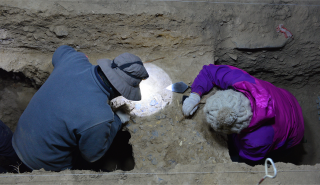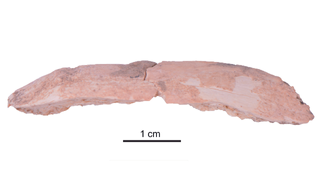A bone from Baishiya Karst cave in Tibet indicates Denisovans were living there roughly 40,000 years ago, well after modern humans had expanded over much of Asia. Combined with previous evidence of their presence in the area 190,000 years ago, the finding reveals extraordinary persistence in the face of exceptionally difficult conditions. It also increases the chances we’re not going to like the answer to the question of what ended this remarkable run.
Extinct members of the humans are always mysterious, but the Denisovans are particularly shadowy. The only known fossil records of them come from three caves, but they live on a little in our genes, or at least the DNA of people with East Asian or Australasian ancestry.
With so much of the picture missing, each new fossil discovery is incalculably precious, but also likely to raise more questions than it answers, as is the case for a rib bone found in Baishiya.
The bone is one of over 2,500 preserved in the cave, dating from 190,000-30,000 years ago – but almost all were from prey, not humans.
Study co-author Dr Geoff Smith of the University of Reading explained in a statement; “We were able to identify that Denisovans hunted, butchered and ate a range of animal species. Our study reveals new information about the behavior and adaptation of Denisovans both to high altitude conditions and shifting climates. We are only just beginning to understand the behavior of this extraordinary human species.”
Most of the bones Smith and co-authors were studying have been so badly broken that previous efforts had been unable to identify their sources. However, by applying mass spectrometry to collagen within the bones, the team was able to match 2,005 of them to a species, or at least a genus, revealing a lot about the changing ecosystem of the area,
Among the yaks, small birds, woolly rhinoceroses, and even blue sheep (no, not green sheep) was a single Denisovan bone. It was dated as being from between 48,000 and 32,000 years ago – a wide range by many standards, but enough to know its owner lived during the last Ice Age and after modern humans had spread through Asia.
Co-author Dr Jian Wang, of Lanzhou University, said, “Current evidence suggests that it was Denisovans, not any other human groups, who occupied the cave and made efficient use of all the animal resources available to them throughout their occupation.”

Digging at Baishya Karst Cave is a slow process, made no easier by the lack of oxygen for those without the Denisovan high altitude genes.
Image Credit: Dongju Zhang’s group (Lanzhou University).
The discovery confirms that Denisovans used the cave during the last Ice Age as well as the one before. Prey continued piling up during the interglacial period, so Denisovans were almost certainly responsible for that as well, even if we don’t have examples of their own bones at the time.

The Denisovan rib bone, broken during excavation. So far its owner is not known to have been nicknamed Adam.
Image Credit: Dongju Zhang’s group (Lanzhou University).
Baishiya Cave has long been a place of pilgrimage for Buddhists, but we can only speculate if local memories of its ancient use contributed to it being seen as sacred.
In 2019 it was revealed that inhabitants there 160,000 years ago were Denisovans, not Neanderthals as previously thought. This marked the first finding of Denisovan bones outside the cave for which they were named. More precisely it was probably the first identification of Denisovan bones elsewhere – it’s likely we’ve found their bones in other places and attributed them to other branches of the human family tree.
Denisova Cave is a forbidding enough place today. At the same latitude as London, it gets much colder in winter thanks to being thousands of kilometers from the moderating effect of the oceans. Baishiya, at the eastern edge of the Tibetan Plateau, is a lot further south, but is also 3,300 meters (10,800 feet) above sea level, making it far colder still. To live there during an ice age, the Denisovans must have been extraordinarily cold-adapted.
On the other hand, the fact their genes are today most abundant in New Guinea proves they could handle the warmth as well. Perhaps their greatest legacy to modern humans are the genes that allow modern Tibetans to thrive in the low oxygen conditions at such heights.
Yet for all this, Denisovans themselves are gone, and their DNA a tiny proportion of the modern gene pool. “The question now arises when and why these Denisovans on the Tibetan Plateau went extinct,” Dr Frido Welker of the University of Copenhagen said. Considering that modern humans were by this point well established in surrounding areas, the answer is unlikely to be nice.
The study is published open access in the journal Nature.
Source Link: Denisovans Survived For 160,000 Years In One Of Earth’s Harshest Places